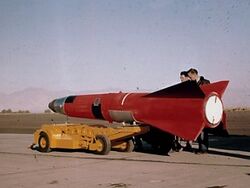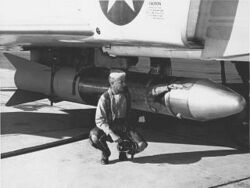Engineering:NOTS-EV-2 Caleb
 Caleb launch vehicle on loading trolley | |
| Function | Expendable launch system Sounding rocket Anti-satellite weapon |
|---|---|
| Manufacturer | United States Navy |
| Country of origin | United States |
| Size | |
| Height | 4.9 metres (16 ft) |
| Diameter | 0.6 metres (2 ft 0 in) |
| Mass | 1,350 kilograms (2,980 lb) |
| Stages | One (test) Two (test) Four (unflown) |
| Capacity | |
| Payload to LEO | 7 kilograms (15 lb) |
| Launch history | |
| Status | Retired |
| Launch sites | Point Arguello San Nicolas |
| Total launches | 2 Caleb 2 SIP 3 Hi-Hoe |
| Successes | 1 Caleb (1 stage) 2 SIP 1 Hi-Hoe |
| Failures | 1 Caleb 2 Hi-Hoe |
| First flight | Caleb: 1960-07-28 SIP: 1961-10-01 Hi-Hoe: 1961-10-05 |
| Last flight | Caleb: 1960-10-24 SIP: 1962-05-05 Hi-Hoe: 1962-07-25 |
The NOTS-EV-2 Caleb, also known as NOTS-500, Hi-Hoe and SIP was an expendable launch system, which was later used as a sounding rocket and prototype anti-satellite weapon. It was developed by the United States Navy's Naval Ordnance Test Station (NOTS)[1] as a follow-up to the NOTS-EV-1 Pilot, which had been abandoned following ten launches officially classified as failed missions.[2] Two were launched in July and October 1960, before the cancellation of the project.[1] Following cancellation, two leftover Calebs were used in the Satellite Interceptor Program (SIP), while three more were used as sounding rockets, under the designation Hi-Hoe.[1] These derivatives flew until July 1962, when the Hi-Hoe made its final flight.
Development
The Caleb was originally designed as a fast-response orbital launch system, to place small reconnaissance satellites, and other military payloads, into orbit at short notice.[3] The orbital configurations were four-stage vehicles, whilst test launches used one- and two-stage configurations. The project was cancelled due to pressure from the United States Air Force , who were responsible for all other orbital launches conducted by the US military, and no attempts to launch the vehicle into orbit were made.[1]
Caleb was an air-launched rocket, with its two launches being conducted from F4D Skyray #747, the same aircraft used in the Pilot trials.[4] Hi-Hoe was also air-launched. It was released from an F4H Phantom II, which provided greater performance.[3] SIP launches were conducted from a ground launch pad on San Nicolas Island.[5] The aircraft used for the airborne launches took off from Point Arguello, which later became part of Vandenberg Air Force Base , currently Vandenberg Space Force Base.[5]
Operational history
The Caleb made its maiden flight, in a single-stage test configuration,[4] on 28 July 1960.[6] Its second flight was made on 24 October of the same year,[6] and used a two-stage configuration. It was unsuccessful, due to the second stage's failure to ignite.[4] Both test launches were suborbital.[7]
Both SIP launches used the two-stage configuration. The first was conducted on 1 October 1961. It was successful and reached an apogee of 20 kilometres (12 mi). The second test, launched on 5 May 1962 was also successful, and reached the same apogee.[5] The three Hi-Hoe launches were conducted on 5 October 1961, and 26 March and 25 July 1962.[6] On the first two launches the second stage failed to ignite,[4] however the third was successful, and reached an apogee of 1,166 kilometres (725 mi).[5][6]
Despite the program's turn towards success, the project was cancelled soon after the final Hi-Hoe test, the Department of Defense choosing to concentrate on the U.S. Air Force 's Blue Scout sounding rocket program.[7]
Launch history
| Date/Time (GMT) | Rocket | S/N | Outcome | Remarks[5] |
|---|---|---|---|---|
| 1960-07-28 | Caleb | TV-1 | Success | Single-stage |
| 1960-10-24 | Caleb | TV-2 | Failure | Second stage failed to ignite |
| 1961-10-01 | SIP | SIP-1 | Success | Ground launch |
| 1961-10-05, 19:10 | Hi-Hoe | NC17.116 | Failure | Second stage failed to ignite |
| 1962-03-26, 19:03 | Hi-Hoe | NC17.121 | Failure | Second stage failed to ignite |
| 1962-05-05 | SIP | SIP-2 | Success | Ground launch |
| 1962-07-25, 15:41 | Hi-Hoe | NC17.117 | Success |
See also
- List of sounding rockets
- ASM-135 ASAT
- NOTS-EV-1 Pilot
- Jaguar (American rocket)
References
- ↑ 1.0 1.1 1.2 1.3 Scott, Jeff (2006-04-23). "NOTSNIK, Project Pilot & Project Caleb". Aerospaceweb.org. http://www.aerospaceweb.org/question/spacecraft/q0271.shtml. Retrieved 2009-06-04.
- ↑ Wade, Mark. "Project Pilot". Encyclopedia Astronautica. Archived from the original on 2008-12-30. https://web.archive.org/web/20081230070244/http://www.astronautix.com/lvs/propilot.htm. Retrieved 2009-06-04.
- ↑ 3.0 3.1 Parsch, Andreas (2003-10-17). "NOTS NOTS-EV-2 Caleb". Directory of U.S. Military Rockets and Missiles, Appendix 4. Designation-Systems.Net. http://www.designation-systems.net/dusrm/app4/caleb.html. Retrieved 2009-06-04.
- ↑ 4.0 4.1 4.2 4.3 Krebs, Gunter. "Caleb (NOTS-EV-2)". Gunter's Space Page. http://space.skyrocket.de/doc_lau/caleb.htm. Retrieved 2009-06-04.
- ↑ 5.0 5.1 5.2 5.3 5.4 Wade, Mark. "Caleb". Encyclopedia Astronautica. Archived from the original on 2016-03-03. https://web.archive.org/web/20160303201513/http://www.astronautix.com/lvs/caleb.htm. Retrieved 2009-06-04.
- ↑ 6.0 6.1 6.2 6.3 McDowell, Jonathan. "NOTS-500". Orbital and Suborbital Launch Database. Jonathan's Space Page. http://planet4589.org/space/lvdb/launch/NOTS500. Retrieved 2009-06-04.
- ↑ 7.0 7.1 Comments on "Caleb" by Joel W. Powell and K.W. Gatland. Spaceflight magazine.
 |




